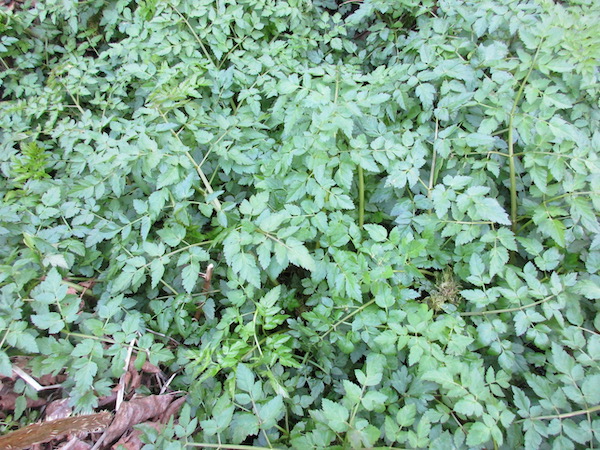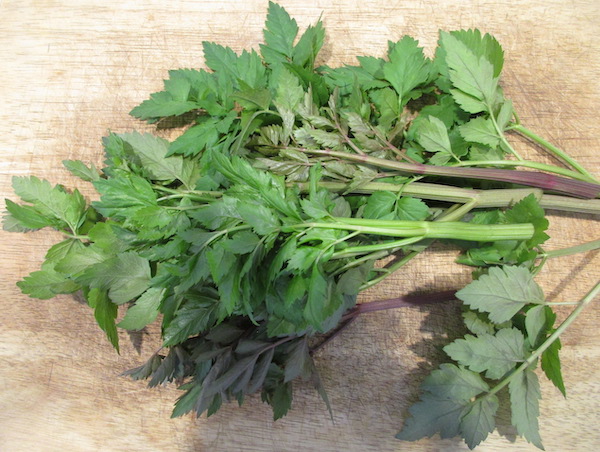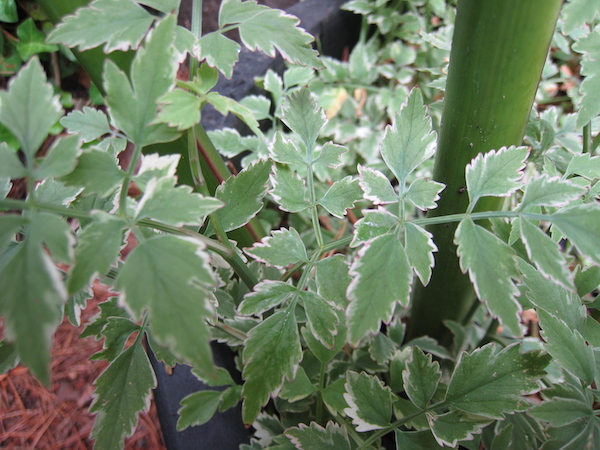| Œnanthe is a genus of 33 species of annual, biennial or (mostly) perennial plants of mostly North temperate regions, mostly the Old World: Eurasia, tropical African mountains to Indomalayasia. Most species are local; aquatic or thriving in wet ditches, sluggish streams, marshes or moist meadows. They often have tuberous parsnip- or turnip-like roots. All species are hairless, their succulent stems with dissected leaves that recall those of carrot, celery or parsley. Tiny white or pink-tinged flowers are in umbels. In some, the flowers are wine-scented; Greek oinos (wine) and anthos (flowers). Though 8 species are noted as edible, 3 are toxic from polyalkynes (polyacetylenic alcohols; n-C2H2) such as oenanthotoxin. The east Asian Œnanthe javanica is the only well known species both as an edible and as an ornamental. (There is also a bird genus named Œnanthe). |
The 3 toxic Œnanthe species are as follows:
|
| 1. Œnanthe aquatica L. |
| (Fine-leaved Water-Dropwort. Water Fennel) |
Europe to N Iran & Mongolia. Annual or biennial; without tuberous roots.
|
| 2. Œnanthe crocata L. |
| = Œnanthe apiifolia Brot. |
| (Hemlock Water-Dropwort. Dead Tongue) |
Madeira, W Europe to W & C Mediterranean. The most toxic species. It resembles a parsley but has a yellow sap. Its perennial deadly roots recall dahlias is appearance, but smell and taste like parsnips. The toxin attacks the central nervous system and causes salivation, pupil dilation, convulsions, vomiting and persistent seizures, which can lead to respiratory arrest and rapid death. The roots are most toxic, especially in winter and early spring. The toxicity is not reduced by drying. Possibly heat detoxifies --as detoxified roots have been reported as a famine food.
|
| 3. Œnanthe fistulosa L. |
| (Common or Tubular Water-Dropwort) |
Europe, Morocco to Iran. Acrid & toxic. Nonetheless, leaves cooked in Turkey! Roots & young leaves cooked in S Italy! Roy Genders reports its flowers are scented deliciously of matured port wine.
|
The 8 non-toxic Œnanthe species, reported as eaten by people, are as follows:
|
| 1. Œnanthe benghalensis (DC.) Miq. |
Bangladesh & China. Young shoots a vegetable.
|
| 2. Œnanthe javanica (Bl.) DC. |
| = Œnanthe japonica (Miq.) Drude |
| = Œnanthe stolonifera Wall. ex DC. |
| (Korean Watercress. Vietnamese Celery. Oriental Celery. Indian Pennywort. Water Celery. Javan Water-Dropwort. Japanese: Seri. Thai: Phàk an) |
Pakistan to China, SE Siberia, E & SE Asia to New Guinea. A well known, popular traditional vegetable of SE Asia. All parts eaten.
|
| 3. Œnanthe linearis Wall. ex DC. |
| = Œnanthe sinensis Dunn |
| (Fine-leaved Water-Dropwort. Water Fennel) |
Nepal & Tibet to Taiwan and Vietnam. Leaves eaten.
|
| 4. Œnanthe peucedanifolia Pollich |
| (Wild Parsley. Sulphur Wort) |
Europe and Algeria. Roots eaten.
|
| 5. Œnanthe pimpinelloides L. |
| (Meadow Parsley. Corky-fruited Water-Dropwort. Earthnut) |
Europe to Caucasus & Israel. Swollen roots eaten. Leaves eaten raw or cooked.
|
| 6. Œnanthe sarmentosa C. Presl ex DC. |
| = Œnanthe californica S. Wats. |
| (Pacific Water-Celery. Pacific Water-Parsley) |
Alaska into California. Tuberous roots boiled have mild parsnip flavor. Young tender stems are good cooked in April or early May. This is also known as Pacific water-parsley but looks far more like celery. It is a semiaquatic perennial, common in sopping-wet soil, sun or shade. It frequently is seen along streamsides, lake shores, etc. The whole plant often is bronzy or purplish-green. It is hairless, and its succulent rank stem flops about or clambers to about 5 feet tall on adjacent plants. Small white or pink-tinged flowers are borne from June into October. The compound leaves have a weak celery odor and flavor. The base of the stem is swollen into a sort of tuber, from which stringy white roots extend into the mud.
|
| 7. Œnanthe Thomsoni C.B. Cl. |
Nepal, Tibet to Burma. Leaves & stalks raw or cooked.
|
| 8. Œnanthe virgata Poir. |
| = Œnanthe anomala Durieu & Coss. |
NW Africa. Leaves.
|
| The remaining 22 other species are undeclared as to edibility or toxicity, as far as I am aware. |
I eat the cooked greens of my native Seattle species, Œnanthe sarmentosa, which is related closely to the well known Œnanthe javanica. Cooking the greens guards against certain organisms that can cause sickness in plants collected and consumed from wet ditches. The native species is more frost-tolerant than the SE Asian species. For me to walk from home to collect greens, and return, takes only 15 minutes. The plant grows in shade or sun. The SE Asian species is sold locally mostly in its variegated-leaf cultivar 'Flamingo' (see my photo). If you are not certain of correct identification, you ought not eat any such plants, because you may misidentify and consume a poisonous species.
Back |

Œnanthe sarmentosa ; in April ; photo by ALJ
|

Œnanthe sarmentosa ; in June ; photo by ALJ
|

Œnanthe sarmentosa ; greens to be cooked ; photo by ALJ
|

Œnanthe javanica ; variegated foliage ; photo by ALJ
|

